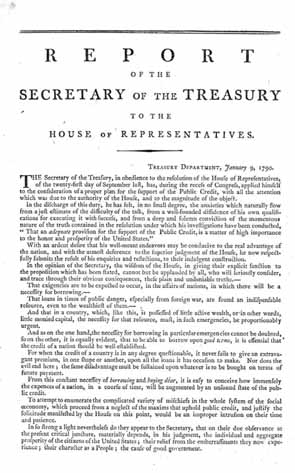
Report on the Public Credit, January 9, 1790
(Courtesy of the Library of Congress)
Congress assigned Hamilton a complex task, but for almost a decade both he and the Confederation Congress had given considerable thought to the issues involved. In this report he proposed to fund the debt rather than pay off the principal as rapidly as possible. This meant creating from federal revenues a fund set aside to make regular and long term payments of the interest on the debt. To make the bookkeeping more manageable, new debt certificates would be printed to consolidate the various types of certificates issued during the Revolutionary War. In addition, he supported the assumption of the state debts, the creation of an excise to pay the costs of the assumption, and the establishment of a national bank. Hamilton's masterful report met with quick endorsement from most members, but James Madison led the opposition to two of his proposals. Madison favored discriminating between the original holders of the debt (for example, soldiers and those who had loaned Congress money) and holders who had purchased the certificates at less than face value. Also, he opposed the assumption of the Revolutionary War debts of the states as part of the federal debt. Congress began debate on the report on February 8 and concluded action on the Funding Bill on July 29. One New Yorker observed at the beginning of the debate: New York City "is all in a flame about funding, nothing else heard even among the women and children." (William Neilson to John Chaloner, February 17, 1790, Clements Library) |